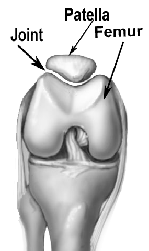The patello- ee joint, it often has its own set of problems which cause
pain, instability swelling etc
ee joint, it often has its own set of problems which cause
pain, instability swelling etc
Disorders of the patello-
Unlike the hip joint, which is a ball and socket joint, the patello-
Because of it’s lack of structural constraints,it is more dependent on the surrounding soft tissues to keep it in place. Any condition which weakens those soft tissues , therefore lead to less controlled movement of the patella and subsequently to pain. Thus problems are very common in people who tend to have lax joints. Similarly, any condition which weakens the muscles around the knee will also tend to destabilise the PFJ Joint.
This is why physiotherapy is often a mainstay treatment for these disorders but also in the event that surgery is needed, physiotherapy still remains very important to achieve full rehabilitation and recovery.
If the groove that the patella sits in is particularly shallow or if the knee sits rather high in the groove it is much more prone to these abnormal movements and so to dislocation.
Thus it seems that some people are built in a way that makes them prone to disorders of the knee cap.
Dislocation of the knee Where the patella moves completely out of its joint is a well recognised injury. It can often be extremely painful and the patient may have to be taken to hospital to have the patella put back in place. The knee will remain swollen and painful for some time afterwards, and as a result the muscles will weaken and in some cases the patella can then redislocate without much force being applied. See section on recurrent dislocation
Some patients present with knee without dislocation or subluxation, just with a painful knee. Typically this will occur on climbing up or down stairs, crouching and kneeling, or even keeping the knee in one place for a length of time.
Instability or giving way of the knee is a very common symptom in those who have unstable or painful knee caps and often leads to them seeking professional advice
Not all disorders of the knee Require surgery and in fact most of them do quite well with conservative treatment which will be discussed in some of the later sections
| Personal Details |
| Orthopaedic Surgical Team |
| Personal Results |
| Background Information |
| Sports Injury |
| Arthritis |
| Surgical Guides |
| Pre Operative Guides |
| Post Operative Guides |
| Alexandra Hospital |
